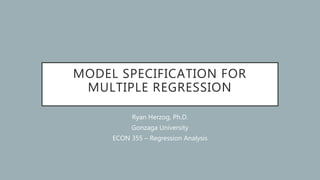
Topic 6 (model specification)
- 1. MODEL SPECIFICATION FOR MULTIPLE REGRESSION Ryan Herzog, Ph.D. Gonzaga University ECON 355 – Regression Analysis
- 2. MEASURES OF FIT • R-squared • Standard Error of the Regression
- 3. R-SQUARED • The regression R2 measures the fraction of the variance of Y that is explained by X; it is unitless and ranges between zero (no fit) and one (perfect fit) • By simply looking at R-squared of a regression we will not be able to say much, we need to have at least two regressions to compare them • All else equal we want to be able to explain a higher share of variance in Y • Stata: • Use California school dataset • Regress test scores on class size. The R-squared is 0.0512. This means that class size explains about 5% of the variance in test scores. • Regress test scores on expenditure per student. What is the R-squared? How would you interpret it?
- 4. INTERPRETING R-SQUARED • An increase in R-squared does not necessarily mean that an added variable is statistically significant • A high R-squared does not mean that the regressors are a true cause of the dependent variable • A high R-squared does not mean that the coefficients on the regressors are true • A low R-squared does not mean that the coefficients on the regressors are wrong • A high R-squared does not necessarily mean that you have the most appropriate set of regressors, nor does a low R-squared necessarily mean that you have an inappropriate set of regressors.
- 5. R-SQUARED RULES • Same dependent variable • Same number of independent variables • Stata: • generate ltestscr=ln(testscr) Generate a table with the regressions below (use outreg) • Regress test score on class size and expenditure per student • Regress natural log of test score on class size • Regress test score on class size and average district income • Regress expenditure per student on average district income • Regress natural log of test score on average district income • Regress natural log of test score on class size and expenditure per student
- 6. STANDARD ERROR OF THE REGRESSION • The SER is a measure of the spread of the observations around the regression line measured in the units of the dependent variable • SER is an estimator of the standard deviation of the regression error 𝑢𝑖 • All else equal we want to have a smaller spread of the observations around the regression line • In Stata SER is called root MSE (mean squared error) • In the regression of class size on test score the SER is about 18.6. This means that the standard deviation of the regression residuals around the regression line is 18.6 points. • We can use SER to compare models • What are the SERs for the rest of the regressions you have run? What does that mean?
- 7. CAUSAL EFFECTS AND IDEALIZED EXPERIMENTS • Most of our questions concern causal relationships among variables, i.e. does lower class size lead to higher test scores? • Causality means that a specific action leads to a specific measurable consequence • The best way to measure a causal effect is by conducting an experiment • In a randomized controlled experiment there is both a control group and a treatment group. Assignment to a group happens randomly • We would like to be able to show that the only systematic reason for differences in outcomes between the treatment and control groups is the treatment itself • In practice, it is not possible to perform ideal experiment. This however, gives us a benchmark.
- 8. NONRANDOM SAMPLE EXAMPLE - 1 • In 1936 the Literary Gazette polled a “random” sample of households chosen from telephone records and automobile registration • In 1936 many households did not have cars or telephones, and those that did tended to be richer – and were also more likely to be Republican • The results of the poll indicated the Landon (a republican presidential candidate) would defeat an incumbent (Roosevelt) by a landslide – 57% to 43% in the 1936 election • Roosevelt ended up winning by 59% to 41% • Do you think surveys conducted using social media might have a similar problem with bias?
- 9. NONRANDOM SAMPLE EXAMPLE - 2 • Some mutual funds simply track the market, some are actively managed by full-time professionals. • Do the latter mutual funds outperform the former? • One way to answer the question is to use historical data on funds currently available for purchase, however this means that the most poorly underperforming funds would not be represented. • The sample is selected based on the value of the dependent variable, returns, because funds with the lowest returns are eliminated • The mean return of all funds would then be lower than the mean return of those still in existence. This is also called a survivorship bias. • When corrected for survivorship bias it turns out actively managed funds do not outperform the market
- 10. NON-RANDOM SAMPLE EXAMPLE 3 • Does the class size affect the test scores with only districts where average class size is above 20 students included? • What is the average height of a GU student measured outside of a basketball locker room?
